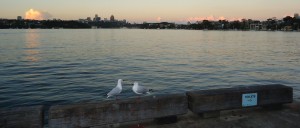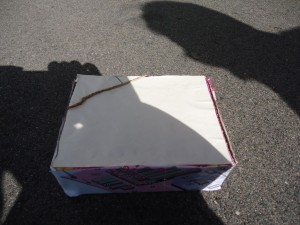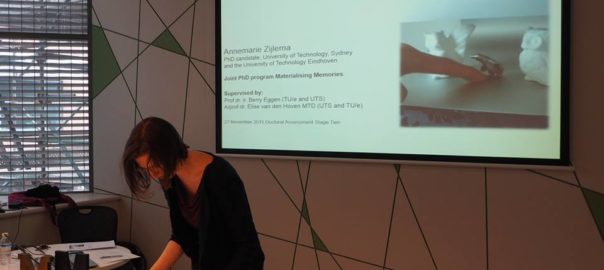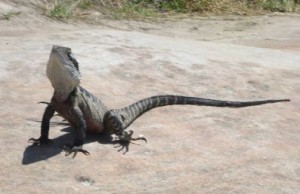
Last week the annual ‘design thinking’ camp for first-year design students at UTS took place on Cockatoo Island (a former convict area, later shipyard, and now tourist destination in the midst of Sydney Harbour). Besides our PhD research, ‘Materialising Memories’ team member Doménique and I work as a tutor in this interdisciplinary course. Around 500 students participated from various design disciplines, such as fashion, interior design, animation, integrated product design and visual communication. Elise (project leader Materialising Memories) was also involved as a lecturer in the ‘design thinking’ course and as a support staff member during the three-day camp.
The students worked in multidisciplinary teams and had to explore and map the island, and on the last day, some teams presented amazing results. Each team created three maps of self-chosen themes from very basic material, like pieces of carton, fabric, or wood in a very short period of time.
One of my favourites was a work made by a student group who wanted to map personal memories of Cockatoo Island. From the outside it showed an abstract representation of the island. The contours of the major buildings and objects on the island where nicely depicted by embroidered lines on the fabric. But that was not the interesting part. The map could be divided in small boxes, like a puzzle. The group had been asking rangers, tutors, students and other visitors on the island what would serve as a memory cue for them to remember their experience on Cockatoo Island. The students had created these memory cues and put them in the boxes.
 Work created by Rekha, Jackie, Georgia, Sugih and Sylvia, Design Camp 2014
Work created by Rekha, Jackie, Georgia, Sugih and Sylvia, Design Camp 2014
While presenting their work to their fellow students and me on the final day, one of the boxes was melting in the sun. It was the chocolate that served as a memory cue for their own experience of Cockatoo Island, relating to their most prominent food while working with each other on the three maps. From my own experience, chocolate seems to be a very unreliable cue as it often disappears all of a sudden. 😉
 And my own memories of Cockatoo Island? I want to remember the enthusiasm of the students and their willingness to learn from each other; the lovely and inspiring conversations I had with other tutors and staff members; the long and very tasty dinner which was prepared by the head of school for the staff and tutors involved; the instruction told by fellow tutor Clare on how to fold the Sydney Opera House out of a serviette; and the walk with A/prof Bert Bongers and his projections of traces from the past on the Cockatoo Island buildings. I did no mapping myself during the camp, so I better write about my experiences.
And my own memories of Cockatoo Island? I want to remember the enthusiasm of the students and their willingness to learn from each other; the lovely and inspiring conversations I had with other tutors and staff members; the long and very tasty dinner which was prepared by the head of school for the staff and tutors involved; the instruction told by fellow tutor Clare on how to fold the Sydney Opera House out of a serviette; and the walk with A/prof Bert Bongers and his projections of traces from the past on the Cockatoo Island buildings. I did no mapping myself during the camp, so I better write about my experiences.
 On 22 March the Materialising Memories team (and some MM friends) left their offices to embark on their fifth Making Memories Day. Our team outing started in the afternoon in The Rocks, the oldest part of Sydney, for an Urban Hunt (interactive scavenger hunt). We split up in two teams and via an interactive Messenger chat we received questions and cryptic clues. By following these cryptic walking directions and searching for the right answers, we passed small alleys and historical places and facts in The Rocks we had never seen or known before.
On 22 March the Materialising Memories team (and some MM friends) left their offices to embark on their fifth Making Memories Day. Our team outing started in the afternoon in The Rocks, the oldest part of Sydney, for an Urban Hunt (interactive scavenger hunt). We split up in two teams and via an interactive Messenger chat we received questions and cryptic clues. By following these cryptic walking directions and searching for the right answers, we passed small alleys and historical places and facts in The Rocks we had never seen or known before. After a short Ferry and Light Rail ride we arrived at our dinner place, The Tramsheds. Some more team members joined us here who were not able to attend our afternoon activity. We enjoyed our dinner in a restored Sydney tram.
After a short Ferry and Light Rail ride we arrived at our dinner place, The Tramsheds. Some more team members joined us here who were not able to attend our afternoon activity. We enjoyed our dinner in a restored Sydney tram.






